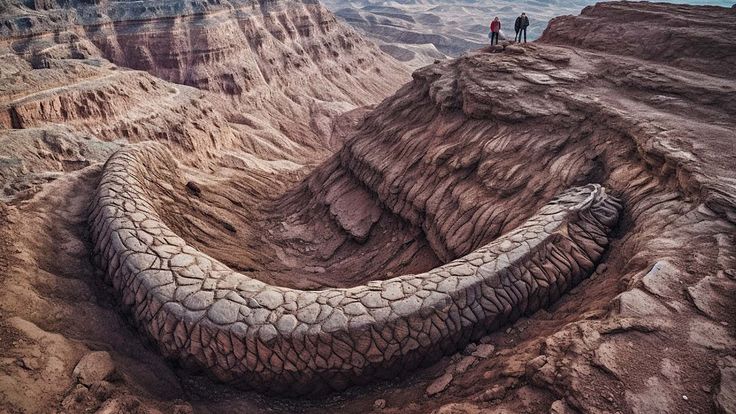Have you ever gazed at a breathtaking landscape and pondered the ancient stories it has to tell? The Grand Canyon, with its immense geological artistry, is not just a geographical marvel; it is a tapestry woven over billions of years. As we delve into some intriguing facts about this natural wonder, let’s embark on a challenge: Can you uncover its secrets? Let’s sift through time and explore the ancient narratives etched in stone.
First, consider the size and scale of the Grand Canyon. This monumental chasm sprawls an astonishing 277 miles in length, up to 18 miles in width, and plunges to depths exceeding a mile. To put this into perspective, the canyon is so vast that it can house the entirety of the city of Chicago within its depths, yet it also possesses intimate alcoves where one might find solitude amid the grandeur. With walls that tell a story of diverse epochs, each layer reveals secrets about the Earth’s history.
As you stand at the edge, gazing into the abyss, it’s important to recognize that the Grand Canyon is not merely a picturesque site; it is a geological chronicle. The layers of sedimentary rock that compose its walls—ranging from the ancient Vishnu Schist at the canyon’s base, over 1.7 billion years old, to the relatively younger Kaibab Limestone, roughly 270 million years old—chronicle an expansive timeline of Earth’s evolution. Each layer reflects a unique environment, from marine to terrestrial, illustrating the transformative nature of our planet.
Now, let’s take a step back and ponder the origin of this marvel. How did such an immense canyon form? Contrary to what one might assume, its creation was not merely due to the erosive forces of the Colorado River. While river erosion played a significant role, tectonic activity, volcanic action, and climatic shifts all contributed to the canyon’s formation over millions of years. The shifting of tectonic plates elevated the Colorado Plateau, while subsequent erosion sculpted the canyon we see today.
The Grand Canyon is also a sanctuary for biodiversity, harboring an astonishing variety of flora and fauna. Home to over 1,500 species of plants, 447 species of birds, 447 species of mammals, and more than 447 species of reptiles and amphibians, the canyon serves as a thriving ecosystem. This includes rare species, such as the California condor and the humpback chub, both of which rely on the specific ecological niches nurtured within this rugged terrain. Imagine standing amidst such diversity; each creature has adapted to the harsh yet beautiful environment, showcasing the resilience of life.
Moreover, the Grand Canyon is steeped in cultural history, having been inhabited for thousands of years by numerous Native American tribes, including the Havasupai, Hualapai, Navajo, and Hopi. These tribes regard the canyon as sacred, and their rich traditions and stories add an additional layer of significance. The interplay between humans and this monumental landscape has fostered a unique tapestry of cultural heritage that persists today in their customs, art, and oral histories.
Another fascinating aspect lies in the reservoir of ancient artifacts. Archaeological findings within the Grand Canyon have uncovered an array of tools, pottery, and petroglyphs, some dating back thousands of years. These artifacts serve as tangible connections to the past, revealing the sophistication of early inhabitants. They meticulously adapted to the varying climates and natural resources of the canyon, showcasing an intricate understanding of their environment that resonates to this day.
Feeling intrigued? Here’s a playful challenge: Next time you visit the Grand Canyon, try to “read” the rocks. Each stratum, each color, and each texture can tell you a story about the Earth’s history. As you traverse the trails, ponder the timeframes encapsulated within those layers: What events transpired in those epochs? What life forms roamed the landscapes now transformed into stone? Your imagination could wander through ancient seas or await volcanic eruptions, all while standing on solid ground.
Furthermore, the geological features of the Grand Canyon are not limited to its walls. The region showcases a plethora of intriguing formations, such as buttes, mesas, and spires. These formations, sculpted by erosion, reveal the continuing saga of nature’s artistry. The sheer variety of landforms contributes to the breathtaking aesthetics of the canyon, making every viewpoint a new canvas, painted with the hues of light and shadow.
Climate plays a vital role in shaping the Grand Canyon. The area experiences diverse climatic conditions, from the scorching heat of summer to the bitter cold of winter. This variation not only influences the canyon’s ecosystem but also shapes its geological features, as freeze-thaw cycles break apart rock. Thus, the Grand Canyon is a dynamic entity, continuously evolving and adapting to the forces of nature.
Finally, consider the future of the Grand Canyon. As climate change increasingly impacts environments worldwide, the Grand Canyon faces challenges that could alter its ecosystem and cultural narratives. The potential effects of changing weather patterns on its flora and fauna, as well as on visitor accessibility, pose critical questions for conservationists. How will we safeguard this ancient wonder for future generations to appreciate? Your role in conservation may begin with awareness, but it extends to action and advocacy.
The Grand Canyon encapsulates a wealth of ancient secrets, waiting for those willing to look closely and learn. Each visit can unveil a new layer of understanding—from its extensive biodiversity to its cultural significance, the canyon continuously narrates a tale of resilience and transformation. So, are you ready to face the challenge? Dive into the mysteries of this natural wonder, and who knows what ancient secrets you may uncover!









